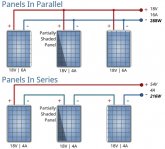Strategies to minimize losses due to partial shading
Even a little bit of shade has the potential to drastically reduce the output of your PV array if strategies aren't taken to minimize losses. The most effective solution by far is to avoid shade if at all possible. For many people, especially those with boat and vehicle based systems, avoiding shade entirely is not a possibility. In these cases it is important to
take steps to mitigate the consequences of shading. The following is an overview of strategies for minimizing losses due to shading.
Avoid Shade
There is no substitute for this, this is far and away the best option. Every other strategy is just a way to mitigate the consequences.
Connect your panels in parallel, or a sensible combination of series and parallel. If you wire in series, the current of the entire string of panels will be reduced to that of the shaded panel. If you wire in parallel, the unshaded panels won't be pulled down by the single shaded panel.
(more info)
 Choose panels that make smart use of bypass diodes. Bypass diodes
Choose panels that make smart use of bypass diodes. Bypass diodes allow current flow around or 'bypass' a shaded part of a solar panel. This is important for efficiency and safety. Similar to how wiring in parallel prevents unshaded panels from being pulled down by a shaded panel, bypass diodes prevent unshaded portions of a panel from being pulled down by a shaded portion. They do this by creating several strings of cells within a panel, if one string is shaded current from the other strings can bypass the shaded portion by flowing through the diode instead, this limits losses and prevents heat buildup in the panel. Almost all modern panels have bypass diodes, but the effectiveness will be based on the number of diodes, and how the strings are laid out.
Below is an example of a conventional panel (left) with 3 strings of cells laid out lengthwise, and an example of a panel that makes smart use of diodes and half cut cells (right) to create 6 strings of cells in a 2x3 configuration.
Choose panels that are optimized for partial shade. It is beyond the scope of this article to discuss specific technologies or product lines. But you should be aware that some panels are better optimized for partial shade than others.
Use multiple MPPT controllers. This is commonly done in the marine industry where partial shade due to sails, rigging, etc. The ideal configuration is one controller per panel, but one panel per zone (for instance port side and starboard side) could also improve efficiency. There are two advantages to multiple MPPT controllers, first, it has the same advantages as parallel wiring (sunny panels are not pulled down by shady panels), second, it improves efficiency of shaded and unshaded panels by calculating their 'maximum power points' individually for the conditions of each panel rather than for the average conditions of the array as a whole.
Panel Level Optimization. Panel level optimization is an umbrella term for techniques of optimizing the output of each panel individually as opposed to optimizing the output of your array as a whole. The latter is the traditional method and works great so long as conditions are mostly uniform across the entire array. Panel level optimization is beneficial when conditions (such as partial shading, orientation or angle) differ across your array. The 'maximum power point' (most efficient point) is tailored to the specific conditions of each individual panel rather than the average conditions across the whole array. There are several types of panel level optimization:
- Per panel MPPT controllers (as explained above)
- Solar Optimizers - Calculate the maximum power point for each panel individually and are connected together in series with one high voltage DC transmission line to a central inverter.
- Microinverters - similar to solar optimizers, but additionally transform the DC output of the panel to AC and have no central inverter
- 4. Maxim Cell Optimizers - When a panel's internal diodes bypass a shaded section of a panel, that power is forever lost. Maxim has a $5 replacement chip for diodes that allows that power to be recaptured and operates the cells at their maximum power point. Essentially for a shaded substring of cells it acts like a boost converter raising the voltage of the stranded energy so that it may join the output of the rest of the panel. It has a 120 mv voltage drop which is lower than the typical bypass diode. Despite NREL issuing an overall positive report on their findings few solar panel manufacturers have incorporated them and it remains a fringe component; for example the Jinko MX panels that have the chip integrated are not available in Australia. The chips are compatible with and will help panels in strings, parallel, or with microinverters. These chips have been known to cause TV reception issues when placed in close proximity to TV antennas and wires.
Consider Blocking Diodes for parallel connected panels or parallel strings of panels. Blocking diodes can be used to prevent current from flowing from a productive (unshaded) panel or string, to a less productive (shaded) panel or string. This is both an efficiency and a safety issue. Blocking diodes are not necessary if you wire in series, or if you use panel level optimization (which is the ideal solution in most cases), but if you have parallel connected panels or strings, it may make sense for you to consider using blocking diodes. A downside to blocking diodes is that using them will result in some voltage drop and power loss.



